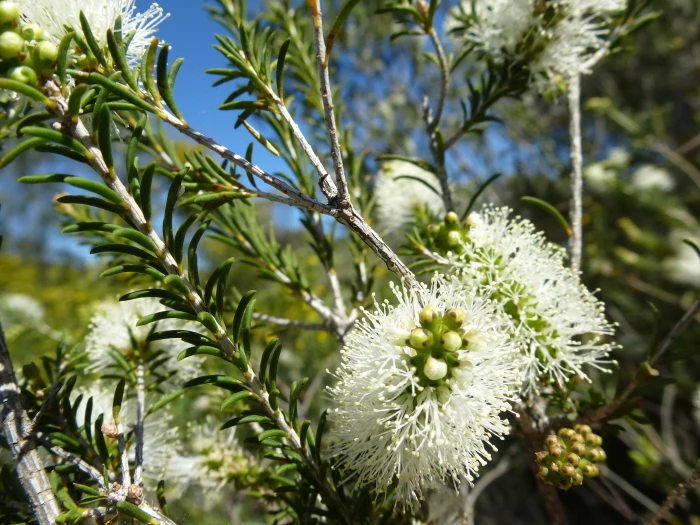Swamp Paperbark
(Melaleuca rhaphiophylla)
Swamp Paperbark (Melaleuca rhaphiophylla)
/
/

Geoff Derrin
CC BY-SA 4.0
Image By:
Geoff Derrin
Recorded By:
Copyright:
CC BY-SA 4.0
Copyright Notice:
Photo by: Geoff Derrin | License Type: CC BY-SA 4.0 | License URL: https://creativecommons.org/licenses/by-sa/4.0 | Uploader: Gderrin | Publisher: Wikimedia Commons | Title: Melaleuca_rhaphiophylla_(leaves,_flowers).JPG | Notes: User created page with UploadWizard |
















Estimated Native Range
Climate Requirements for Richmond, Virginia
| This Plant | Your Site | Plant Suitability for Your Location | ||
|---|---|---|---|---|
| • Precipitation | 11" - 52" | 43" | Aquatic | Aquatic |
| • High Temp. | 74°F - 98°F | 90°F | Your summer temperatures are normal for this plant. | Excellent |
| • Low Temp. | 37°F - 50°F | 27°F | Your winter temperatures may be too cold for this plant | Too cold |
This plant may not grow well at your location - your precipitation is too high.
Summary
Melaleuca rhaphiophylla, commonly known as Swamp Paperbark, is an evergreen tree native to the wetlands, riverbanks, and seasonally inundated plains of Southwest Australia. It can grow as a large shrub or small tree, typically reaching up to 10 m (30 ft) in height. The Swamp Paperbark is characterized by its bushy crown, multi-stemmed growth habit, and distinctive greyish, papery bark that peels away in layers. The flowers are creamy-white, borne in dense heads or spikes at the branch tips and upper leaf axils, with a flowering period that occurs sporadically from May to January. The flowers are moderately showy and attract a variety of pollinators. Following flowering, woody, cup-shaped fruit capsules form in clusters along the stem.
Swamp Paperbark is valued for its adaptability to wet conditions and is often used for revegetation projects in its native range. Its dense growth habit makes it suitable for use as a screening plant, and regular pruning can maintain its shape. It is also planted in gardens for its attractive bark and foliage. This species requires full sun to part shade, tolerates a range of soil types but prefers those with medium drainage, and can withstand both low and medium water conditions. In cultivation, it is relatively low-maintenance, but it can be susceptible to leaf spot diseases in humid climates. Seeds can be harvested from the capsules and propagated as tubestock or sown directly into the ground.CC BY-SA 4.0
Swamp Paperbark is valued for its adaptability to wet conditions and is often used for revegetation projects in its native range. Its dense growth habit makes it suitable for use as a screening plant, and regular pruning can maintain its shape. It is also planted in gardens for its attractive bark and foliage. This species requires full sun to part shade, tolerates a range of soil types but prefers those with medium drainage, and can withstand both low and medium water conditions. In cultivation, it is relatively low-maintenance, but it can be susceptible to leaf spot diseases in humid climates. Seeds can be harvested from the capsules and propagated as tubestock or sown directly into the ground.CC BY-SA 4.0
Plant Description
- Plant Type: Tree
- Height: 20-30 feet
- Width: 5-10 feet
- Growth Rate: Moderate
- Flower Color: White, Cream
- Flowering Season: Winter, Spring, Summer
- Leaf Retention: Evergreen
Growth Requirements
- Sun: Full Sun, Part Shade
- Water: Medium
- Drainage: Medium, Slow
Common Uses
Bee Garden, Bird Garden, Butterfly Garden, Hummingbird Garden, Low Maintenance
Natural Habitat
Wetlands, riverbanks, and seasonally inundated plains of Southwest Australia
Other Names
Common Names:
Scientific Names: Melaleuca rhaphiophylla, Myrtoleucodendron rhaphiophyllum
GBIF Accepted Name: Melaleuca rhaphiophylla Schauer